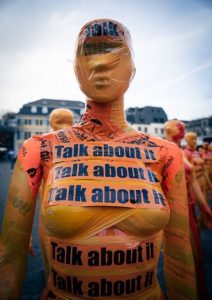Blog
The Weaponisation of Violence Against Women as a feature of Conflict: The Case of Manipur
August 22, 2023
“Your men have raped our women, now we will do the same.”
The Indian state of Manipur lies in the north-east of India. Like other northeastern states, it is largely isolated from the rest of India. It tragically rose to prominence this year when a video of two women, stripped naked and forcefully paraded in public, was widely circulated on social media. What led to this heinous state of affairs? Anne Mary Shaju of SOAS investigates:
Gender violence in conflict serves not only to attack the bodies of individual women. It also undermines the dignity of whole communities. We have seen this played out in recent shocking incidents in Manipur, India where a survivor recounts hearing a mob shouting the words quoted above. This example shows that violence based on gender is multifaceted, and therefore requires intersectional analysis.
What is happening in Manipur?
The current (2023) conflict in Manipur started when the Kuki ethnic group clashed with the Meitei people over economic benefits and quotas given to the tribes. The Meiti are in the majority and have lived in the prosperous valley region for generations. In April 2023, the Kuki opposed the extension of affirmative quotas to Meiteis, believing this would further disadvantage Kukis and another tribal group, the Naga. Rivalry intensified when the Manipur High Court ruled that the government should consider the Meiteis demands for special benefits.
Women and ‘honour.’
Bigio and Vogelstein (2017) discuss how selective targeting of victims from opposing ethnicity or religion or political group is a terrorising tactic that, for the attackers, also has the ‘advantage’ of invoking shame by making the bodies of women ‘impure.’ Women subjected to gender violence are then charged with bringing shame to their community. The community is itself shamed because it has failed to “protect” the victim of gender/sexual violence. This of course raises questions of ‘ownership’ of women’s bodies. In communities in India where women are tied to socially-constructed notions of ‘honour’ and ‘purity’ as dictated by traditionally-patriarchal societies, assaulting the body of a woman can become an act of revenge. During the horrific events that took place during partition of India following independence, we saw parallels being drawn between ‘manhood’ and nationalism. Bhutalia (1998) writes that “the country, variously referred to as Bharat, or Hindustan, was imagined as a female, as the mother, and in this reading, partition was seen as a violation of her body. Many Muslim and Hindu women from both India and Pakistan were abducted and assaulted by men from the opposing sides, their bodies becoming currency in ‘honour-bound’ violence. Tragically, we see this repeated in episodes of violence such as that taking place in Manipur today. This is further entrenched by the actions/reactions of the state, which is cast in the masculine role of protector”. As Golan Nulak, a Kuki activist mentions, it took a video of two Kuki women being paraded naked by a mob, widely shared on social media in July 2023 for the Indian state to intervene in the ethnic conflict that has been taking place in Manipur for more than two months.
Masculinity and Control of Women
Alison (2007) and Tosh (1994) note that the notion of hegemonic masculinity brings with it a certain level of aggression, which is “tied to socially sanctioned institutionalised use of force with the military as the ultimate exemplar of masculinity”. Other scholars have noted that gang-rape can therefore become an act of loyalty and bring a sense of bonding among men asserting their idea of masculinity. Thus, sexual violence function to exert fear which effectively controls women’s bodies while simultaneously asserting masculinity.
Normalisation of sexual violence
Sexual violence against women is often normalised through rape ‘jokes’ and supporting rape culture. Lockyer and Savigy (2020) note that rape jokes do not exist in isolation but are tied to the varied layers of social discrimination, often also invoking other social categories such as race, skin colour, ethnicity, religious belief and other social discriminations.
State as the Perpetuator
The silence from the Indian Prime Minister, Narendra Modi for two months after the ethnic conflict began in Manipur between Kuki and Meiti communities empowered assailants in the Manipur communitiess Unfortunately, this is not an isolated incident, nor is it restricted to particular geographical areas. Indeed, we have seen and heard appallingly misogyny from such characters as Donald Trump of USA and Jair Bolsonaro of Brazil. Furthermore, studies have found that state armed forces statistically commit more sexual violence than rebel forces (Cohen and Nordås, 2014).
Conclusion
Toxic masculinity and hegemonic patriarchy facilitate/legitimise violence against women. As long as these remains fundamental to political, economic, cultural and social structures, atrocities against women will continue. In India, where patriarchy is Brahmanical in nature and therefore intersects with systematic prejudices of the society, sexual violence becomes an act to repress the gender and a means to oppress the caste, tribal or religious identities.
Anne Mary Shaju

